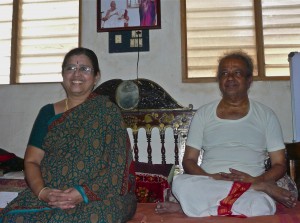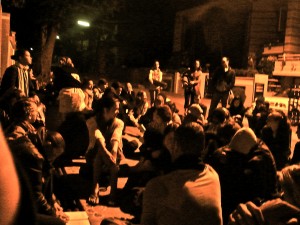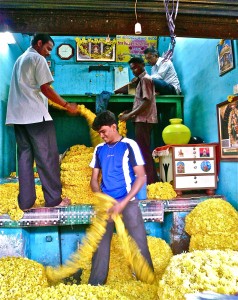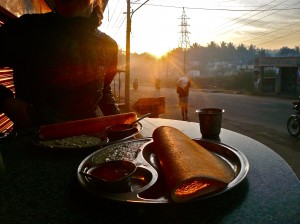Discipline, Affirmation, Emotion
At the Mental Hygiene workshop back in November, Gurjt, Dawn and Yvonne offered a series of intriguing questions about working with emotion.
In sum: given (1) the limitations that go with having a physical body, and given (2) the raw truth of mental/ physical/ emotional/ samskaric pain that yoga makes us look at… well, then to what degree should we cultivate positive emotion and affirmations in practice? When we’re experiencing a lot of physical, mental, emotional crap, should we just willfully change our inner environments? Or is yoga practice more about just observing difficult subjective experience and letting it run its course?
I didn’t even attempt to answer. The reason was that I sort of don’t know. I wanted to leave you some space for not-knowing too.
Not-knowing can be a tricky area for disciplined, dedicated people. So can intense emotion or thought-habits. This is because it’s pretty easy to use strong discipline to repress confusion, doubt or negativity. Because you are such a focused, methodical group, I wanted to offer a bit of a challenge rather than dismissing the question with something as boring as… an answer.
Your concentration and mental clarity are really fun to work with. Not that it matters, but I would submit that your natural gift for discipline (or simply your good choice of practicing with other people who possess this gift, which was the trick my formerly lazy self used to cultivate discipline) will generate increasing clarity and subtlety over time. In ways that will surprise you. Concentration can really snowball on you. (As long-time meditators will affirm, everyday life improves massively after one has a fully developed concentration muscle. But most people will never get any taste of what that feels like.)
Among other interesting things, years of utterly consistent, taken-for-granted, dispassionate practice give a person’s actions a quality of effortlessness. A certain neutrality and luminosity come from practicing deeply enough that comfort-preferences or a need to get rewards are no longer calling the shots. This deep discipline is not super-hero stuff. Super-heroes are for kids.
It’s full-on weird (and exciting) the first time you get to experience a person who is refined in this way. Such people stopped doing practice years ago and are now mostly… being practiced.* As you know, one reason I love Mysore is that I get to dwell absorb the embodied wisdom of dozens of them. As Sharath reminds us about every week, just doing a lot of asana practice doesn’t comb out a person’s ego in this way: it only works like that if we approach practice with a certain honesty and with systematically good intentions.
But sometimes overly strong discipline can push (1) difficult creative impulses, or (2) confusing contemplative insights into unconsciousness. So when big questions come up, sometimes I think my job is to let them sit there, open. Quick answers are trite anyway. And because my teachers and the scriptures are so inspiring and beautiful, I don’t want to use them in a stimulus/response manner. Teachings are not stones: I do not want to throw them at our practice, or use them to plug the openings it creates.
But it’s been a few months, so now some scripture. And damn if the scriptures aren’t good on this stuff. “Self-study†does include contemplating and applying the resources on yama, niyama, physical practice, and concentration. The AY:A2 library is one heck of a resource where this is concerned, and I’ll come home next month with more for the shelves.
Patanjali is the most accessible; and besides I’m fond of anyone who has thousands of gleaming white heads and the habits of a jungle shaman. It turns out that, when negative thoughts or emotions take on a compulsive quality, generating positive emotion and affirmations is COMPLETELY OKAY in his book.
What he calls pratipaksha bhavanam (“cultivate the oppositeâ€) is not a repressive act. It’s a way of replacing stagnant energy with fuel for practice. Read up on this. And if it gets confusing, just talk to me: I can share specific, easy techniques for doing it. Meantime, many of you have done metta practice: you can adapt that technique to support your yoga (see Sutra 1.33).
At the same time, Patanjali has a lot to say about the types of Samadhi – concentration or absorption states. According to most commentators, nirbija samadhi is a nondual, indescribable, elusive, rare occurrence (very different from the samadhi you may learn about in Buddhism or the Psych literature on happiness). But the many forms of sabija samadhi or savikalpa encompass awareness of an object—or “seedâ€â€”of absorbed consciousness. I don’t want to say too much about this, and after just four seasons of sitting with Jayashree and Narasimhan, I’m not much qualified to do so anyway. But briefly, the point here is that Patanjali says there is value in fully “being with†various seeds of awareness in sabija samadhi.
The juice here is in having a full experience of whatever-it-is (for specifics, study up on savitarka, nirvitarka, etc). Note that full experience is RARE. Most of the time, we are being led around by our attractions and repulsions. Distracted from distraction by distraction, as TS Eliot wrote. Yet bare attention to experience, without any effort to change that experience, is essential to yoga in Patanjali’s teaching.
So back to the question of whether we should willfully change our inner environments. When to cultivate the opposite, and when to soak concentration into present experience even if said experience is difficult? I don’t know that either. Commentators have lots to say on the subject: check them out when the time feels right, and put their different insights into relationship with your experience.
Yet also: right now, your guts, hearts and minds have a clue, right? Asana practice with some good intention and sincerity has a way of clarifying and unifying our funny, crazy, adorable, idiosyncratic, distracted mind-bodies so that the clues all start to line up. There is less inner conflict. There is more stability and inner quiet. Gradually, balancing willful transformation with radical acceptance gets… sort of effortless.




